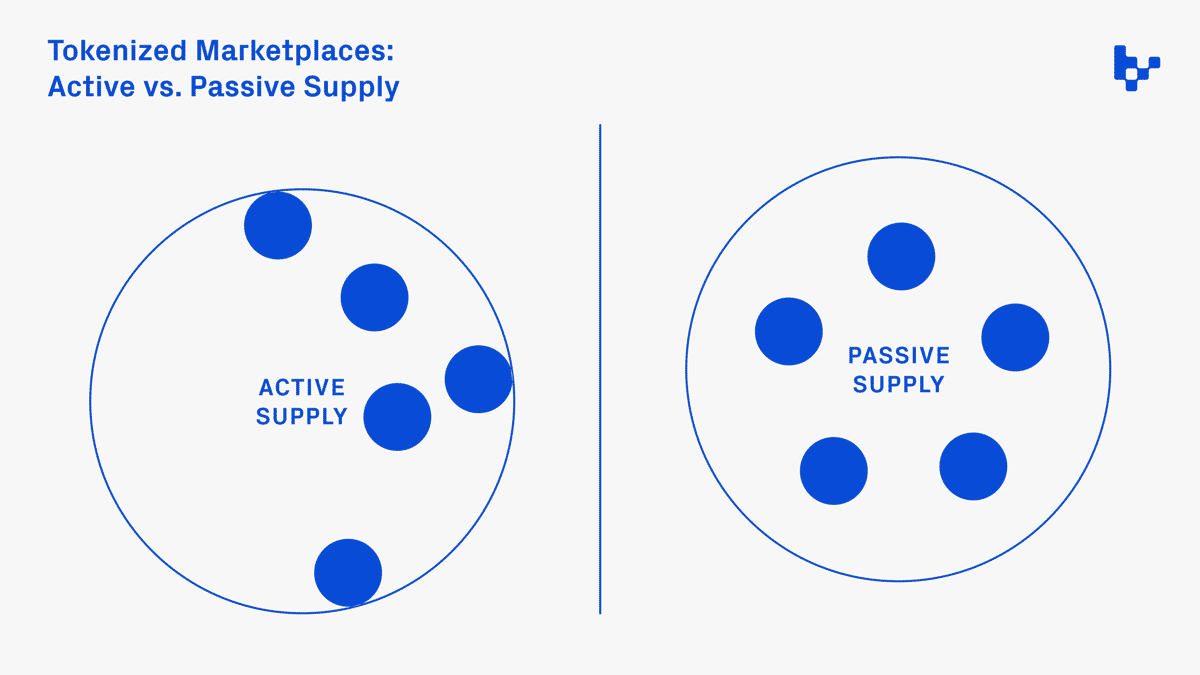Mason Nystrom

Tokenized Marketplaces: Bootstrapping and Scaling Active vs. Passive Supply
Token incentives help marketplaces overcome the cold start problem by allowing them to onboard supply-side participants.
But not all supply is the same.
There’s active supply, meaning it must engage continually in the marketplace. And then there’s passive supply, which requires initial onboarding but minimal ongoing maintenance; it’s set-it-and-forget-it.
Tokenized marketplaces with active supply are much stickier and often have greater defensibility once they get to scale because the compounding nature of demand offers better economics for suppliers. Whoever reaches the greatest demand liquidity first wins because they can provide higher earnings on the supply side, which further spins the flywheel.
Conversely, passively supplied marketplaces are better able to rapidly scale supply growth without an equivalent level of marketplace demand—but their stickiness is harder to secure. Builders can take advantage of these dynamics while bootstrapping a tokenized marketplace, but only if they understand the core tradeoffs of each type.
Active vs. Passive Marketplaces
To understand why active-supply marketplaces tend toward defensibility but are harder to scale—and why passive marketplaces trend the opposite way—it’s essential to look at their general characteristics, each one existing on a spectrum.
Human Labor vs. Resources
Active forms of supply are nearly synonymous with human labor. As of yet, people can’t sit back and passively rent out their brain power like storage space. For example, Braintrust, a decentralized job network, requires constant supplies of human talent to fulfill the real-time demands of employers.
On the other end of the spectrum are resources, such as hardware, NFTs, and capital. These represent passive supplies. For instance, DIMO, a data-sharing network for cars, requires users to buy and connect a DIMO hardware device. After this one-time setup cost, the device continuously streams vehicle data to the DIMO network with little input from the user.
High Opportunity Costs vs. Sunk Costs
In active marketplaces, supply-side participants choose the marketplace with the best combination of income/yield and token-appreciation potential. Axie Infinity, which popularized play to earn, competed with other marketplaces in which users could spend their labor to earn yield. Without strong organic demand, active marketplaces must perpetually compete against all the other ways users could spend their time earning tokens.
Passive marketplaces, however, have upfront or sunk costs in the form of depreciating supply-side assets. As a result, supply-side operators will passively contribute their physical assets to a marketplace so long as it’s profitable to do so. For instance, GPU owners have an incentive to supply their compute power to GPU marketplaces to make the most of their depreciating assets. Even in the absence of demand equilibrium, passively supplied marketplaces can continue to support a high quantity of supply using token incentives.
Quality-Dependent Supply vs. Quality-Independent Supply
It’s far easier to scale a marketplace when you have a clear view of supply quality. Passive-supply marketplaces, with their physical supplies, are better suited to this than active-supply marketplaces. That’s because their supply often comes with quantitative qualifiers that make scaling quality easier. For instance, GPUs have different quantitative classifications (e.g. A100 vs RTX 4090s) that also track quality.
This is seldom the case with active-supply marketplaces, which are dealing with high variations in human capabilities. Gig-based platforms such as Braintrust or Nosh are only as good as their workers, but the demand-side participants will have differing opinions on the quality of those workers.
Token Design Implications
So how should builders go about bootstrapping tokenized marketplaces and getting them to scale? What implications do a marketplace’s supply characteristics have on token design?
Actively Supplied Marketplaces
There are several key token design implications for actively supplied marketplaces:
- Scale token incentives with demand growth
- Incentivize supply-side loyalty, quality, or reliability
- Create dynamic incentives to prevent side-switching
In passive marketplaces, supply can wait for demand to catch up (e.g. Filecoin). Not so in active marketplaces, where humans are dealing with high opportunity costs. Thus, builders must prioritize demand-side growth to remain competitive. However, tokens can help bootstrap initial demand so that supply-side participants want to join the marketplace.
One strategy for scaling active marketplaces is to dynamically scale supply-side incentives so that token distribution closely mirrors growth. A related mechanism is to onboard supply in a permissioned manner, such that a stable or threshold earning rate (e.g. yield) is consistently offered to supply-side participants, which in turn keeps supply-side labor engaged and reliable.
Regardless, this limitation of actively supplied marketplaces actually makes them stickier as they grow—they are able to offer more consistent earnings as demand increases. From an incentive design perspective, such tokenized marketplaces should focus on providing continual rewards that keep users active on the platform. Moreover, they should dynamically adjust these rewards to incentivize users who provide consistent supply over users who churn.
But while token incentives are valuable for bootstrapping supply and demand, some innovation is likely required at the servicing, verification, and reputation layers to scale supply quality, an important characteristic of actively supplied marketplaces.
Here, tokenized marketplaces must take lessons from traditional managed marketplaces. For instance, the RealReal and StockX provide verification services to ensure the physical supply is legitimate. Similarly, Braintrust acts as a middleman and provides a quality-assurance layer as part of its marketplace offering while leveraging tokens to help onboard supply (e.g. referrals) and vet peer-to-peer talent.
Active-supply marketplaces that can leverage the scaling effects of tokens can do even better. By using a network of stake-based intermediaries or a token-incentivized verification and curation layer, they can enhance the quality assurance process and generate more efficient marketplaces.
What about those tokenized marketplaces where supply and demand come from the same users, such as with NFT marketplaces or play-to-earn games like Axie and Stepn?
Side-switching marketplaces will need to be more dynamic when altering token incentives because they are most likely to find that the speculative flywheel of a token can obfuscate organic demand. Marketplaces where side-switching is prevalent can help alleviate the reflexive nature of growth by incorporating vesting and/or other specific lockups into token rewards, incentivizing long-term participation. Actively supplied marketplaces should incentivize greater supply-side diversity to bring on more prosumer and professional supply over retail supply, which can be more fickle.
Passively Supplied Marketplaces
There are also important token design implications for builders of passively supplied marketplaces:
- Scale supply-side quantity aggressively to achieve commercially viable scale
- Build greater defensibility through demand-side products (e.g. SDKs, APIs) or supply-side lock-in via proprietary hardware
- Incentivize supply-side loyalty, quality, or reliability
Passively supplied marketplaces typically require a certain supply threshold to be met before the marketplace is commercially viable (i.e. generates robust demand), so builders should initially focus on supply-side growth. Moreover, this supply is typically measured in quantity, not quality. For instance, data collection networks like DIMO, Hivemapper, and Wynd, need significant data before the aggregated data or services built on top of them become valuable.
Because all passively supplied marketplaces are easier to scale, a new entrant isn’t going to secure demand merely by gathering sufficient liquidity. Instead, it will typically need to compete on product by offering an orchestration/onboarding layer or building SaaS components (e.g. SDKs and APIs) that help demand access the marketplace’s supply. GPU marketplaces like IO.net offer aggregation services that make accessing GPUs easier for end-compute users. Similarly, DIMO has built a marketplace that enables DIMO token owners to purchase services for their cars.
Another way to make passively supplied marketplaces more defensible is by transitioning from commoditized supply to proprietary supply. Wireless marketplaces like Helium and XNET are leveraging proprietary supply to build their telecom infrastructure.
Finally, given the high sunk costs of passively supplied marketplaces, supply will often continue servicing a network so long as rewards outweigh operating costs. When sunk costs are high and opportunity costs are low (e.g. Blackbird restaurants accepting FLY tokens), supply will be more retentive since the supply-side participant has an inherent incentive to service the marketplace. Conversely, when high sunk costs are coupled with high opportunity costs (e.g. GPU owners servicing compute marketplaces), demand or token rewards could be a deciding factor for where supply chooses to allocate resources.
+++
This post is for general information purposes only. It does not constitute investment advice or a recommendation or solicitation to buy or sell any investment and should not be used in the evaluation of the merits of making any investment decision. It should not be relied upon for accounting, legal or tax advice or investment recommendations. You should consult your own advisers as to legal, business, tax, and other related matters concerning any investment. Certain information contained in here has been obtained from third-party sources, including from portfolio companies of funds managed by Variant. While taken from sources believed to be reliable, Variant has not independently verified such information. Variant makes no representations about the enduring accuracy of the information or its appropriateness for a given situation. This post reflects the current opinions of the authors and is not made on behalf of Variant or its Clients and does not necessarily reflect the opinions of Variant, its General Partners, its affiliates, advisors or individuals associated with Variant. The opinions reflected herein are subject to change without being updated.
Variant is an investor in Blackbird, Braintrust, and DIMO.



